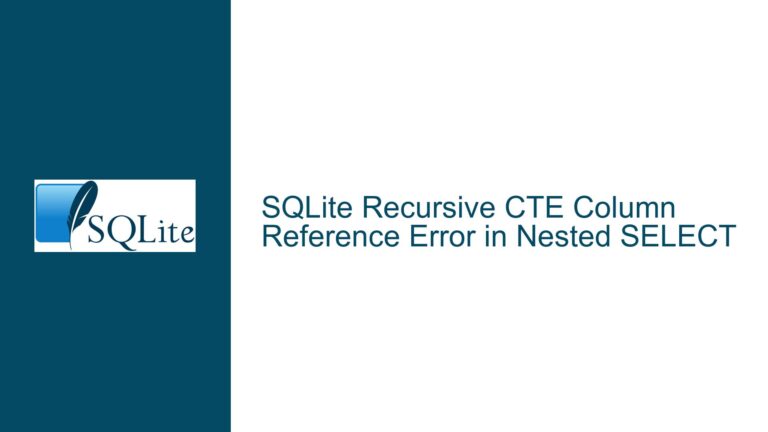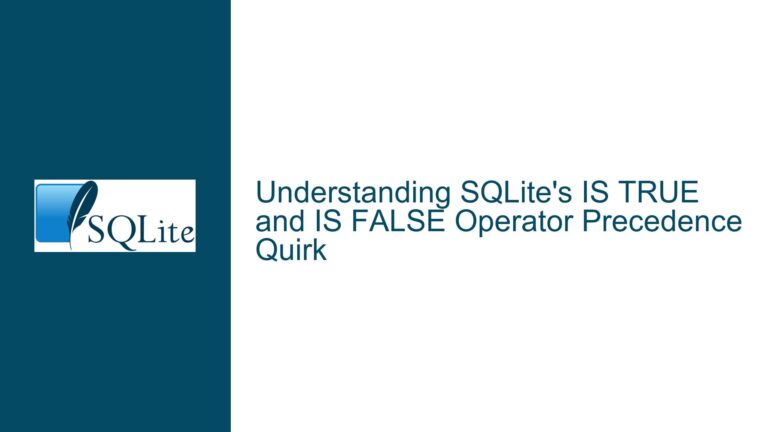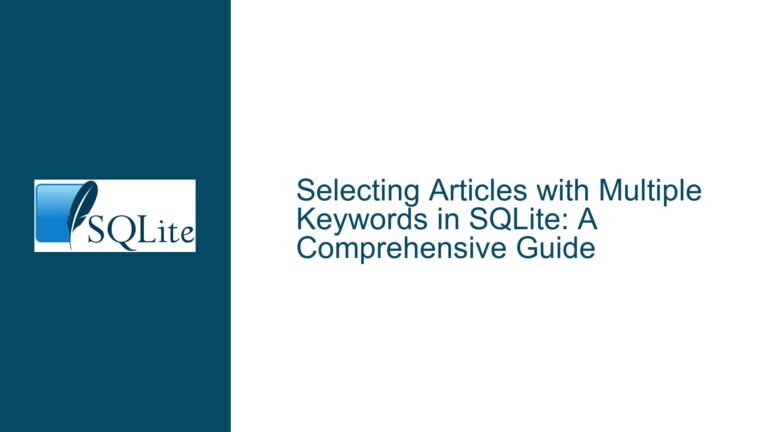Unexpected Behavior of `FULL OUTER JOIN` and `RIGHT JOIN` in SQLite
Understanding the Unexpected Results in JOIN Operations
The core issue revolves around the unexpected behavior of FULL OUTER JOIN and RIGHT JOIN operations in SQLite, particularly when the left side of the join yields an empty set of rows. The problem manifests in two specific scenarios:
Empty Result Set with
FULL OUTER JOIN: In the first query, aFULL OUTER JOINoperation returns an empty result set when the left side of the join (aCROSS JOINwith a condition that evaluates to0) produces no rows. This behavior is unexpected because, logically, theFULL OUTER JOINshould still return rows from the right side (vt0) even if the left side is empty.Inconsistent Behavior with
EXISTSClause: The second query introduces anEXISTSclause that evaluates to0(false), which should theoretically make the query equivalent to the first one. However, this query returns a row from the right side (vt0), which contradicts the behavior of the first query.
The discussion also highlights a broader issue with how SQLite handles RIGHT JOIN and FULL OUTER JOIN operations compared to other databases like MSSQL and PostgreSQL. Specifically, SQLite’s behavior diverges when the left side of the join is another join operation that yields an empty set of rows. This discrepancy raises questions about SQLite’s implementation of these join types and its adherence to standard SQL behavior.
Possible Causes of the JOIN Behavior Discrepancy
The unexpected behavior of FULL OUTER JOIN and RIGHT JOIN in SQLite can be attributed to several factors:
Implementation Differences in Join Operations: SQLite’s handling of
RIGHT JOINandFULL OUTER JOINdiffers from other databases like MSSQL and PostgreSQL. In SQLite, when the left side of the join is another join operation that yields an empty set of rows, the entire query may return no rows, even if the right side contains data. This behavior is inconsistent with the standard SQL expectation, where aRIGHT JOINorFULL OUTER JOINshould still return rows from the right side regardless of the left side’s result.Boolean Evaluation and
CASTOperations: SQLite does not have a native Boolean data type. Instead, Boolean values are represented as integers (0for false and1for true). This can lead to unexpected behavior when Boolean expressions are used in join conditions. For example, the presence or absence of aCASToperation in the join condition can alter the query’s result. In the provided examples, usingCAST(0 AS boolean)in the join condition produces different results compared to using0directly. This inconsistency suggests that SQLite’s handling of Boolean expressions in join conditions may not be fully aligned with standard SQL behavior.Edge Cases in Join Optimization: SQLite’s query optimizer may handle certain edge cases differently, especially when dealing with nested joins or complex conditions. In the first query, the
CROSS JOINwith a condition that evaluates to0results in an empty set, which may cause the optimizer to skip evaluating theFULL OUTER JOINaltogether. This could explain why the query returns an empty result set. In contrast, the second query’sEXISTSclause introduces additional complexity that may force the optimizer to evaluate theFULL OUTER JOINdifferently, resulting in the expected row from the right side.Version-Specific Behavior: The discussion reveals that the behavior of these join operations varies between different versions of SQLite. For example, the latest trunk version of SQLite produces the expected result for the first query, while older versions return an empty set. This suggests that the issue may have been addressed in recent updates, but the inconsistency across versions highlights the importance of testing queries thoroughly, especially when upgrading SQLite.
Troubleshooting Steps, Solutions, and Fixes for JOIN Issues
To address the unexpected behavior of FULL OUTER JOIN and RIGHT JOIN in SQLite, follow these troubleshooting steps and solutions:
Verify SQLite Version: Begin by checking the version of SQLite you are using. The discussion indicates that the latest trunk version of SQLite produces the expected result for the first query, while older versions do not. If you are using an older version, consider upgrading to the latest version to see if the issue persists. You can check your SQLite version by running the following command:
SELECT sqlite_version();Use Explicit Boolean Casting: Since SQLite represents Boolean values as integers, explicitly casting Boolean expressions in join conditions can help avoid unexpected behavior. For example, instead of using
0directly in the join condition, useCAST(0 AS boolean)to ensure consistent evaluation. This approach can help align SQLite’s behavior with standard SQL expectations. For example:SELECT * FROM (SELECT 'a' a) a JOIN (SELECT 'b' b) b ON CAST(0 AS boolean) RIGHT JOIN (SELECT 'c' c) c ON CAST(1 AS boolean);Avoid Nested Joins with Empty Results: If possible, avoid using nested joins that yield empty result sets as the left side of a
RIGHT JOINorFULL OUTER JOIN. Instead, restructure the query to ensure that the left side always contains data or use aUNIONoperation to combine results from multiple queries. For example:SELECT * FROM (SELECT 'a' a) a LEFT JOIN (SELECT 'b' b) b ON 0=1 UNION SELECT NULL, NULL, c FROM (SELECT 'c' c) c;Test Queries Across Different Databases: If you are developing an application that needs to work across multiple databases, test your queries in each target database to identify any discrepancies in behavior. This is especially important for complex queries involving
RIGHT JOINandFULL OUTER JOIN. By identifying and addressing these discrepancies early, you can ensure consistent behavior across different database systems.Review SQLite Documentation: Familiarize yourself with SQLite’s documentation on join operations and Boolean handling. The Boolean Datatype documentation provides valuable insights into how SQLite represents and evaluates Boolean values. Understanding these nuances can help you write more robust queries and avoid unexpected behavior.
Consider Alternative Query Structures: If the issue persists, consider rewriting the query using alternative structures that achieve the same result without relying on
RIGHT JOINorFULL OUTER JOIN. For example, you can use a combination ofLEFT JOINandUNIONto simulate aFULL OUTER JOIN:SELECT a.a, b.b, c.c FROM (SELECT 'a' a) a LEFT JOIN (SELECT 'b' b) b ON 0=1 LEFT JOIN (SELECT 'c' c) c ON 1=1 UNION SELECT NULL, NULL, c.c FROM (SELECT 'c' c) c LEFT JOIN (SELECT 'a' a) a ON 0=1 LEFT JOIN (SELECT 'b' b) b ON 0=1;Report Bugs and Contribute to SQLite Development: If you encounter behavior that you believe is a bug or inconsistency, consider reporting it to the SQLite development team. The SQLite community is active and responsive, and your feedback can help improve the database for everyone. You can submit bug reports and feature requests through the SQLite Forum or the SQLite Bug Tracker.
By following these steps and solutions, you can effectively troubleshoot and resolve issues related to FULL OUTER JOIN and RIGHT JOIN in SQLite, ensuring that your queries produce the expected results across different versions and scenarios.






